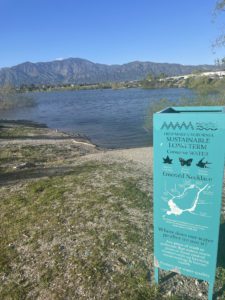When hearing of the emerald necklace, people may think of jewelry or a piece that belongs to a royal, not the Los Angeles River Environmental Water Crisis. The emerald necklace refers to a project that utilizes the space along the LA River to benefit the land and communities it encompasses. The ever-growing environmental water crisis in Los Angeles calls for long-term solutions. The Amigos de Los Rios has worked on this project over the last ten years. However, this project dates to the 1930s. Southern California had been dealing with floods around Riverside, Orange County, and Los Angeles. Facing floods brought an urgency to prevent future floods.
The Olmsted brothers, who were part of planning the parks of New York and Boston, wanted to bring that same vision of green space to Los Angeles—instead, the chamber of commerce chose to excavate our river to create a 51-mile channel. The importance of the emerald necklace is to educate on how to use our waterways in a green space that would prevent flooding, connect communities, and promote land restoration.
Los Angeles River Environmental Origin
The emerald necklace started in 2005, then expanded from 2008-2018. Currently, the space covers a 17-mile loop. It unites ten cities in Los Angeles. Including resident’s from the Rio Hondo, San Gabriel, and East Los Angeles metropolitan. The project has created more parks, bike paths, and beach access, expanded larger parks and trails, and connected communities. With the help of organizations like Amigos de Los Rios, its purpose has gained traction for its ability to protect and preserve the rivers and tributaries of the region.

Due to the Environmental Water Crisis affecting the LA River, there is a need for increasing native habitat conservation, restoration, water quality, and educational initiatives. There is growth around this project, gaining volunteer action to bring awareness and volunteering opportunities. The benefits of having more green space in cities are also worth noting. Placing plants along the waterways makes it much easier for our land to absorb and distribute water. Concrete channels prevent the water from getting absorbed into our water tables. It goes into the ocean, our sewage, gutters, and drains. Aside from water usage, having green space makes the temperature decrease.
Having tree canopies provides shade to our population, cleans up our air, and makes room for humans and animals to have a place to enjoy nature. Creating more bike paths and trails encourages people to explore areas they may not have known about. More restoration and preservation of the land surrounding the LA river helps protect our residential spaces from rising climate change issues.
History of Environmental Water Crisis
 Knowing the origin of the emerald necklace, it might be odd to grasp why Los Angeles County did not approve of the Olmsted Brother’s plan from the beginning for the LA River. An article by the conservation fund explained that in the 1920s, the Chamber of Commerce had considered the Olmsted brothers and Harland Bartholomew and associates of St. Louis on possible project plans. The community leaders were concerned about having fewer parks and developed land to attract people to live here. “They wondered if traffic, air pollution, and swelling populations could negatively impact the country’s future” (conservationfund.org).
Knowing the origin of the emerald necklace, it might be odd to grasp why Los Angeles County did not approve of the Olmsted Brother’s plan from the beginning for the LA River. An article by the conservation fund explained that in the 1920s, the Chamber of Commerce had considered the Olmsted brothers and Harland Bartholomew and associates of St. Louis on possible project plans. The community leaders were concerned about having fewer parks and developed land to attract people to live here. “They wondered if traffic, air pollution, and swelling populations could negatively impact the country’s future” (conservationfund.org).
While the Olmsted brothers’ plan would have brought our metropolitan area to the scale of New York or Boston, taxpayers were not willing to funnel the project. Then with the Great Depression, this project lost its opportunity. It wasn’t until more floodings occurred that eventually pushed for the river to become a channel. California requested Federal assistance to recover from the devastation in1938. That’s how the 51-mile channel came into existence.
It was a solution for an issue that was no longer possible to postpone action. While this did provide a solution to flooding, there is a waste of how that rain and LA River water gets distributed around Southern California. It has affected our drought season, water tables, and water quality. The conservation fund, surrounding communities, and Amigos de Los Rios has been educating on how it can be possible to change the channels and get the emerald necklace back on track.
Present-Day Los Angeles River Environmental Water Crisis
Thus to move forward, let’s briefly review the past historical floodings and how residents overcame them. Before the Spaniards, Native Americans flourished in their application of irrigation systems. They respected mother nature, believing we were an interconnected web, utilizing the land efficiently for humans and the environment. Also, Native Americans throughout California planted crops along floodplains. This took advantage of high water when the rivers became overflowed. Thus it kept the soil healthy and promoted absorption within. Floodplain irrigation was used instead of canal irrigation along the Rio Grande. Side note, in surrounding states that had deeper rivers, natives did build canals and boats!
When Spaniards came to what is now the greater Los Angeles area, they built the Pueblo of Los Angeles. Additionally, in 1825, a massive flood created swamps from the original Pueblo to the Pacific Ocean. Furthermore, this historical event caused the Los Angeles River to flow into its now southern current. Then in 1815, another LA flood caused the San Fernando Valley to flood and took the water systems in place with it. Three rivers run underground, with shallow surfaces in dry seasons, which causes heavy winter flooding. Later in 1904, aquifers were depleted by wells utilized for agriculture expansion. William Mulholland, then superintendent of LA Water company, suggested introducing other water support systems.
Sign ificances of Water Crisis
ificances of Water Crisis
Our mismanagement of drought and flooding was a pattern that needed to be addressed. Finally, California pursued federal assistance after the devasting floods in the 1930s.From 1938 to 1960, the army corps of engineers channelized the Los Angeles River to control water levels from future floods. In 2023, Los Angeles again faced unprecedented rainfall, which caused flooding in greater Los Angeles, raising the need to reevaluate our water systems. Therefore with the help of the conservation fund and amigos de Los Rios, people are working on stabilizing our waterways and finding solutions that will enrich our environment from future flooding and the ever-growing climate crisis.
Sources
“EMERALD NECKLACE FOREST TO OCEAN EXPANDED PLAN.” The Conservation Fund
Amigos De Los Rios – Emerald Necklace Group, 24 Oct. 2022 .
“HISTORY OF THE LOS ANGELES RIVER.” LACDPW: Los Angeles River Watershed, LACDPW. Hlady, Nikola.
“The Emerald Necklace Vision for a Healthier L.A. County.” KCET, 1 Mar. 2017
